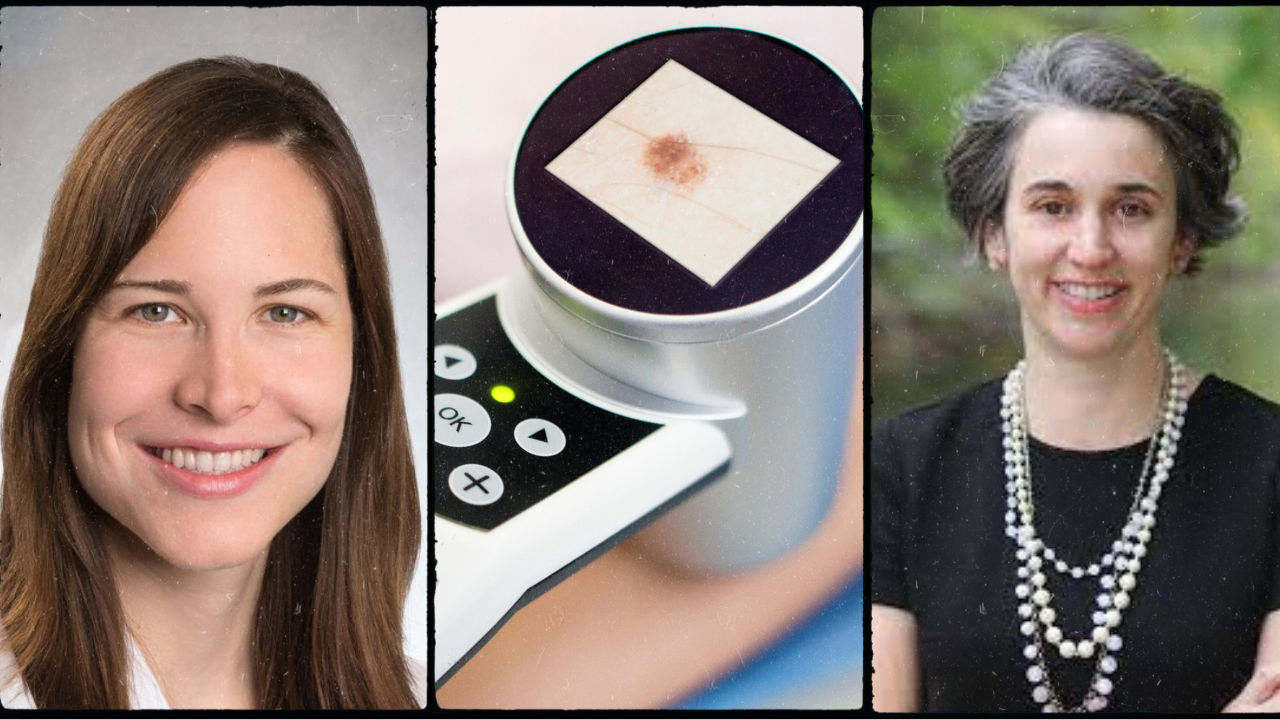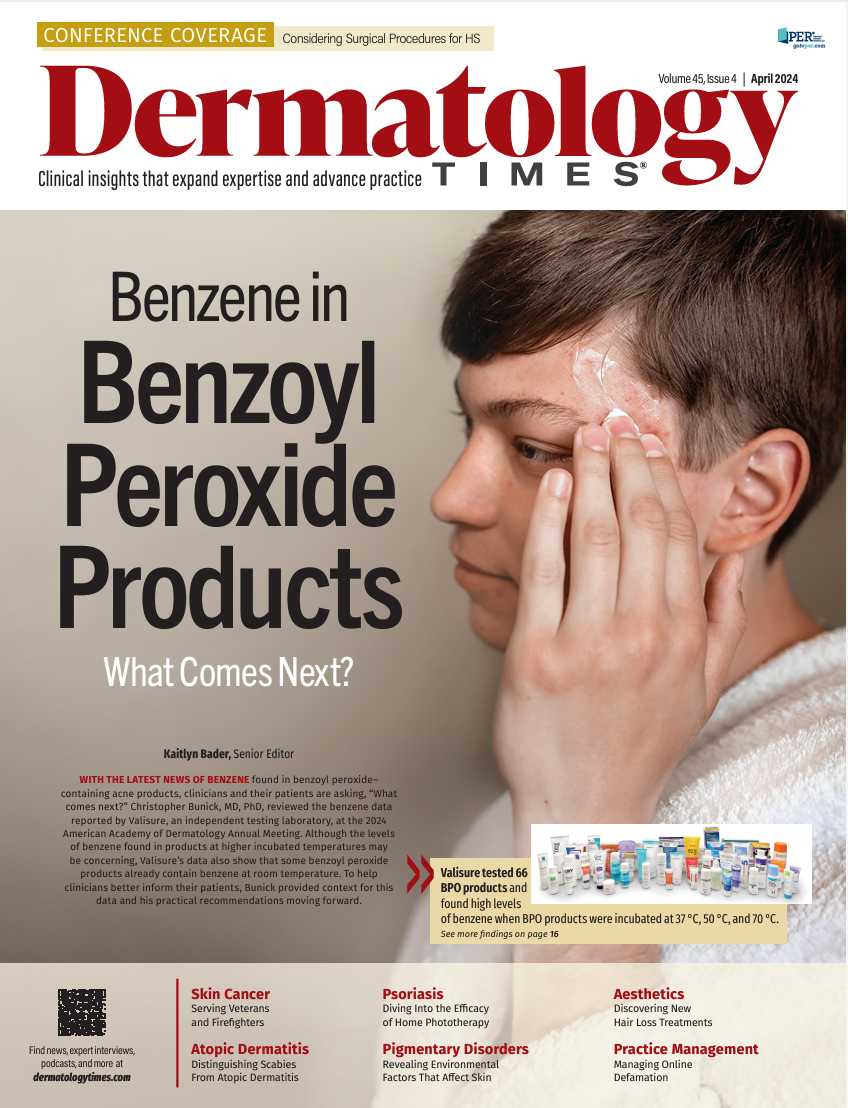- General Dermatology
- Eczema
- Alopecia
- Aesthetics
- Vitiligo
- COVID-19
- Actinic Keratosis
- Precision Medicine and Biologics
- Rare Disease
- Wound Care
- Rosacea
- Psoriasis
- Psoriatic Arthritis
- Atopic Dermatitis
- Melasma
- NP and PA
- Skin Cancer
- Hidradenitis Suppurativa
- Drug Watch
- Pigmentary Disorders
- Acne
- Pediatric Dermatology
- Practice Management
Serving Those Who Serve Our Communities: Melanoma in Veterans and Firefighters
Rebecca Hartman, MD, MPH, FAAD, and Christine Kannler, MD, FAAD, took a deep dive into considerations and pearls to treat patients who have been exposed to extreme heat and chemicals in the line of duty.
Left to Right: Rebecca Hartman, MD, MPH, FAAD, and Christine Kannler, MD, FAAD, have dedicated their careers to research and treatment of veterans and firefighters with occupational hazards that impact the skin..

The landscape of melanoma risks presents a nuanced challenge for dermatology clinicians, especially when addressing high-risk groups like firefighters and veterans. During the session “Melanoma in Special Populations” at the 2024 American Academy of Dermatology Annual Meeting, Christine Kannler, MD, FAAD, dermatologist at Northeast Dermatology Associates in North Andover, Massachusetts, and Rebecca Hartman, MD, MPH, FAAD, Rebecca Hartman, MD, MPH, FAAD, assistant professor of dermatology at Brigham and Women’s Hospital, chief of dermatology at the VA Boston Healthcare System, shared insights on the unique occupational hazards, demographic considerations, and preventive measures in military and firefighter populations.1
Understanding Occupational Hazards
There are currently more than9 million veterans receiving health care in the United States.2The health care challenge posed by ultraviolet (UV) exposure and skin cancer risks among American military personnel is highly specific, particularly in the deployment setting. Military pilots and crew members, both military and civilian, face increased incidence rates of 2.4 times and mortality rates of 1.9 times when exposed to flight conditions, while Operation Ranch Hand Air Force veterans experience a 1.7 times adjusted incidence rate due to chemical exposures.3Service members operate in an environment where adhering to regular sun protection measures can be challenging. A survey revealed that fewer than 30% of respondents among soldiers reported consistent sunscreen use during deployment, leaving their skin unprotected for 70% of the time or more. This issue is complex and arises from factors such as limited access to sunscreen, insufficient emphasis on sun protection practices, harsh weather conditions, and the prioritization of immediate safety concerns over preventive care. Additionally, the military population is predominantly male, with 85% being men, and male sex is correlated with lower sunscreen utilization.4
The interconnected exposure history of firefighters and veterans poses distinctive challenges in melanoma risk assessment. Kannler pointed out, “A lot of firefighters have served in the military, and so then we're having 1 exposure out to the next." Firefighters, as Kannler illustrated, are constantly exposed to aerosolized carcinogenic particles when battling blazes. This exposure occurs not only through inhalation but also through skin absorption, especially in high-risk areas like the groin, neck, and jaw. In fact, firefighting as an occupation is classified as a group 1 carcinogen.
One systematic review aimed to investigate the melanoma risk among career firefighters, given their exposure to carcinogenic combustion byproducts during firefighting activities. The review utilized case-control studies to explore this risk, excluding studies on volunteer firefighters or those at the World Trade Center on September 11, 2001. Out of 334 identified articles, 5 met the inclusion criteria. The studies predominantly used state tumor registry data and identified occupation through registry responses or fire marshal's office certifications. The review found that 4 out of 5 studies reported an increased melanoma risk in male firefighters compared to non-firefighters. Despite using police as controls in some studies due to demographic similarities, the results varied. One study reported increased risk in older firefighters compared to police, while another found reduced risk compared to police but increased risk compared to all occupations aged 18 to 54 years.5
However, the review faced limitations, including the inability to isolate occupational exposures from other risk factors, such as UV exposures or personal/familial history of skin cancer. Additionally, the focus on career firefighters may limit the generalizability of the results to all firefighters, and the exclusion of women in most studies underscores the need for more inclusive research.5
Melanoma-Specific Survival
While veterans exhibit worse melanoma-specific survival, Hartman introduced a positive trend. "Since 2015, for metastatic disease, we saw veterans had a better melanoma-specific survival than in Surveillance, Epidemiology, and End Results [SEER] in recent research," she said in the session. “This positive shift may be attributed to factors such as improved access to treatment within the VA Health System and potential responsiveness to immunotherapy among older males.”
The research she mentioned was a study evaluating how the SEER program, a comprehensive database covering a substantial portion of the US population, may not accurately represent the unique demographic and risk factors prevalent among veterans. This limitation impeded the understanding of melanoma epidemiology within this high-risk population. Thus, this study aimed to bridge this gap by comparing demographics, tumor characteristics, and melanoma-specific survival (MSS) between veterans and the general population. Data spanning from 2009 to 2017 were collected from the Veterans Affairs Cancer Registry (VACR) and SEER,comprising 18 registries. Analysis of 15,334 cases among veterans and 166,265 among SEER patients with melanoma revealed notable differences. Veteransexhibited a higher propensity for presenting with regional or distant disease compared to SEER counterparts. Additionally, the 5-year MSS was consistently lower in VACR across all age groups, except for individuals aged ≥80 years. Despite these disparities, both cohorts displayed a recent improvement in stage IV MSS, with veterans experiencing a notable increase from 37.8% to 51.5% between 2015 and 2017. However, limitations, including unique veteran demographics and missing data inherent to VACR, must be considered when interpreting these findings. In conclusion, while veterans tend to be diagnosed with melanoma at later stages compared to SEER, the observed improvement in stage IV MSS suggests promising advancements in melanoma management within this population.6
Educational Interventions and Opportunities to Give Back
Both veterans and firefighters exhibit gaps in awareness about melanoma risks. Hartman emphasized, "Nearly half [of service members] were not at all aware of their skin cancer risk from the military." Hartman also pointed out the improved accessibility of cancer screening due in part to the pandemic, with artificial intelligence support tools to enhance telemedicine and bringing mobile teledermoscopy to rural regions to screen service members who often live there.
Kannler has a personal tie to this education initiative and has dedicated her career to giving back to firefighters and those who have served. Her brother, Peter, was a firefighter and died at the age of 37 of esophageal cancer. That sparked her interest in the effect of the occupational hazards on the skin. As a dermatologist, she brought AAD’s Skin Cancer Screening Programs to fire houses and set up a booth at the 2024 AAD Annual Meeting to demonstrate these checks. Because of Kannler’s dedication to this population, the academy has amplified the importance of its Firefighter Skin Cancer Checks Program to provide skin checks to firefighters across the country. To reach this population, AAD has partnered with the Firefighter Cancer Support Network and needs the participation of member volunteers in every state.
References
- Hartman. R, Kannler C. Melanoma in Special Populations. Presented at: 2024 American Academy of Dermatology Annual Meeting; March 8-12, 2024; San Diego, CA.
- Administration VH. Veterans Affairs. VA.gov. June 10, 2009. Accessed March 12, 2024. https://www.va.gov/health/aboutvha.asp#:~:text=The%20Veterans%20Health%20Administration%20(VHA,Veterans%20enrolled%20in%20the%20VA.
- Brown M. Toxicological assessments of Gulf War veterans. Philos Trans R Soc Lond B Biol Sci. 2006;361(1468):649-679. doi:10.1098/rstb.2006.1825
- Riemenschneider K, Liu J, Powers JG. Skin cancer in the military: A systematic review of melanoma and nonmelanoma skin cancer incidence, prevention, and screening among active duty and veteran personnel. J Am Acad Dermatol. 2018;78(6):1185-1192. doi:10.1016/j.jaad.2017.11.062
- Valek SA, Rousseau MA, Nelson KC, Kannler C, Tran T. Melanoma risk among career firefighters: A systematic review of case-control studies. J Am Acad Dermatol. 2023 May;88(5):1189-1192. doi: 10.1016/j.jaad.2022.11.058. Epub 2022 Dec 31. PMID: 36592739.
- Eid E, Maloney NJ, Cai ZR, Zaba LC, Kibbi N, John EM, Linos E. Risk of Multiple Primary Cancers in Patients With Merkel Cell Carcinoma: A SEER-Based Analysis. JAMA Dermatol. 2023 Nov 1;159(11):1248-1252. doi: 10.1001/jamadermatol.2023.2849. PMID: 37703005; PMCID: PMC10500424.

